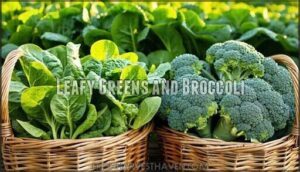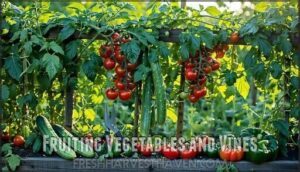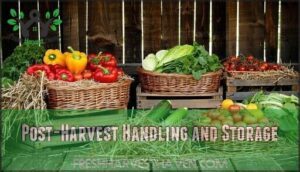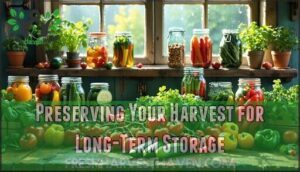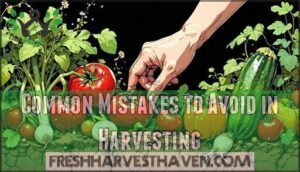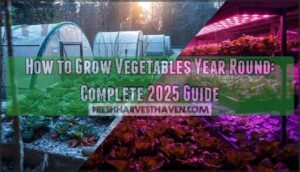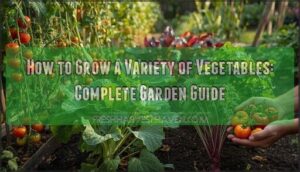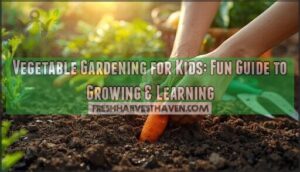This site is supported by our readers. We may earn a commission, at no cost to you, if you purchase through links.
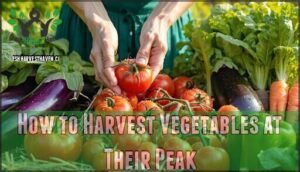 Knowing how to harvest vegetables at their peak makes all the difference between bland and brilliant produce.
Knowing how to harvest vegetables at their peak makes all the difference between bland and brilliant produce.
You’ll want to check your garden daily for signs like vibrant colors, firm textures, and proper sizing.
Morning hours work best since vegetables are crisp and full of moisture.
Use sharp pruning shears or knives to avoid damaging plants – think surgeon, not lumberjack.
Different vegetables have unique tell-tale signs: tomatoes yield slightly to pressure, carrots pull easily from soil, and lettuce leaves feel substantial but tender.
Timing isn’t just everything – it’s the secret ingredient that separates good gardeners from great ones, and understanding this concept is key to achieving brilliant produce and becoming a great gardener.
Table Of Contents
- Key Takeaways
- General Harvesting Tips
- How to Harvest Vegetables at Their Peak
- Harvesting Techniques by Vegetable Type
- Signs of Ripeness in Vegetables
- Tools and Equipment for Harvesting
- Post-Harvest Handling and Storage
- Preserving Your Harvest for Long-Term Storage
- Common Mistakes to Avoid in Harvesting
- Frequently Asked Questions (FAQs)
- When should a home gardener harvest vegetables?
- How do you harvest vegetables?
- Why are vegetables picked at their peak quality?
- How do you know if a vegetable is ready for harvest?
- What should I do if I find vegetables past harvest time?
- What should you keep in mind when harvesting vegetables?
- How do you maximize harvest?
- How do you know when vegetables are ready to harvest?
- What vegetables take the longest to harvest?
- Is it better to harvest vegetables in the morning or at night?
- Conclusion
Key Takeaways
- Time your harvest for early morning hours – You’ll capture peak sweetness and crispness when vegetables are hydrated from overnight dew and before heat builds up during the day.
- Learn each vegetable’s unique ripeness signals – You can’t rely on one-size-fits-all methods since tomatoes need slight give, carrots pull easily from soil, and broccoli requires tight 4-6 inch heads before flowering.
- Use sharp, clean tools and handle gently – You’ll prevent plant damage and bruising by cutting with precision rather than yanking, treating your harvest like precious cargo from garden to storage.
- Check your garden daily during peak season – You’ll catch that perfect ripeness window since vegetables can go from perfect to overripe quickly, and regular picking encourages continued production.
General Harvesting Tips
You’ll get the best flavor from your vegetables when you harvest them at the right time and handle them with care.
Timing your harvest for early morning hours and using proper techniques can mean the difference between bland produce and vegetables that taste amazing.
Using proper techniques is crucial for maintaining the quality of your vegetables.
Harvesting at The Right Time
Despite what you might think, perfect timing beats perfect weather in the context of harvesting vegetables. Your garden’s treasures hit their flavor peak during specific windows, and missing them means missing out on maximum taste.
Catch that perfect moment—your vegetables are only at their flavor peak once!
Harvest at the right moment to taste your veggies at their absolute best—timing turns good into garden gold!
Early morning harvests deliver the sweetest results. After dew dries but before heat builds, vegetables are crisp, hydrated, and packed with natural sugars. Daily monitoring becomes your secret weapon for catching those peak harvest times when ripeness indicators align perfectly.
Seasonal variations affect when vegetables mature, so stay flexible with your harvesting guide. Summer crops race to maturity, while fall vegetables take their time.
- Check plants daily for vegetable maturity signs
- Harvest in cool mornings for ideal timing
- Follow seasonal patterns for yield improvement
Checking for Ripeness
Visual Ripeness becomes your best friend when determining harvest time. Your vegetables practically speak to you through their appearance and feel.
Color changes tell the story—deep reds in tomatoes, vibrant greens in broccoli, and golden hues in squash signal peak ripeness. Texture Indicators matter just as much. Gently press your produce; ripe vegetables yield slightly without being mushy.
Don’t skip Aroma Assessment. Fresh corn smells sweet, while ripe melons develop that characteristic fragrance near the stem. Taste Testing works for greens—sample a leaf to check for bitterness.
Remember, Size Matters in your vegetable ripeness guide. Smaller often means sweeter:
- Baby carrots offer more tender sweetness than oversized ones
- Medium zucchini taste better than baseball bat-sized monsters
- Compact broccoli heads provide superior flavor over loose, flowering ones
These vegetable maturity signs help you identify ripe vegetables every single time. Consider that ethylene gas production also plays a role in the ripening process.
Handling Vegetables Gently
Since vegetables bruise easily, you’ll want to master gentle handling techniques that preserve peak freshness.
Use sharp tools for clean cuts instead of yanking stems—nobody wants damaged produce.
Cradle each vegetable carefully and avoid squeezing too hard.
Choose proper containers for harvesting vegetables, then practice careful sorting and gentle washing afterward.
Smart stacking methods prevent bruising during transport.
Handle your harvest like you’re holding something precious, because you are.
These simple steps guarantee your vegetables maintain their quality from garden to table.
How to Harvest Vegetables at Their Peak

Getting the perfect harvest means knowing your vegetables and watching for the right signs of ripeness.
You’ll need to understand each variety’s unique timing, from checking color changes to testing firmness, so you can pick at peak flavor.
Understanding Vegetable Variety
Your garden’s success hinges on understanding that every vegetable variety has its own personality. Think of it like hosting a dinner party—you wouldn’t serve everyone the same meal at the same time.
Heirloom varieties often ripen differently than hybrid vegetables, with unique ripeness signs you’ll need to learn. Regional differences also play a huge role in vegetable maturity. What works in California mightn’t match your growing conditions in Minnesota.
Here’s what makes each variety special:
- Nutritional variations: Some varieties pack more vitamins than others
- Ripeness timing: Cherry tomatoes ripen faster than beefsteaks
- Harvesting windows: Bush beans give you one big harvest, while pole beans keep producing
- Storage potential: Certain varieties last longer after picking
Smart vegetable harvesting starts with knowing your specific varieties. Check seed packets for maturity dates, but remember—these are estimates. Your plants will tell you when they’re truly ready through their own harvesting tips and signals.
Timing of Harvest
Harvest-timing mastery separates good gardens from great ones. You’ll maximize flavor and yield impact by understanding each vegetable’s optimal timing.
Most vegetables reach peak ripeness during cool morning hours when sugars concentrate overnight. Check daily for ripeness signs—color changes, size, and firmness tell the real story beyond seed packet dates.
Weather effects can shift schedules dramatically. Hot spells accelerate maturity while cool snaps slow it down. Don’t rely solely on calendar dates; your eyes and hands are better judges.
Harvesting vegetables at their optimal time requires frequent garden visits, especially during peak season. Stagger plantings to extend harvest windows and prevent overwhelming abundance.
Regular picking encourages continued production in many crops. Knowing when to harvest, such as waiting for eggplant’s shiny finish, is key.
Determining Ripeness
Your vegetable’s ripeness signals tell a story worth reading carefully. Recognizing peak ripeness combines sharp observation with gardening intuition—and these four techniques will make you a harvest detective.
- Visual Ripeness: Look for vibrant, rich colors like deep red tomatoes or golden butternut squash. Dull, faded hues mean they’re not ready yet.
- Texture Signals: Gently squeeze your vegetables. You want firmness with slight give—not mushy or rock-hard resistance.
- Size Matters: Check seed packets for maturity guidelines. Oversized vegetables often lose their sweetness and tenderness.
- Aroma Indicators: Fresh, sweet scents signal readiness. Follow up with Taste Confirmation—take a small bite to verify vegetable maturity and confirm signs of ripeness align perfectly.
Harvesting Techniques by Vegetable Type
You’ll need different methods for harvesting your vegetables because what works for lettuce won’t work for carrots buried underground.
Each type of vegetable requires its own approach, from gently cutting leafy greens with sharp tools to carefully loosening soil around root vegetables before pulling them up, which involves a unique technique for each, such as carefully loosening.
Leafy Greens and Broccoli
Understanding specific harvesting techniques helps you maximize your garden’s potential.
Leafy greens like spinach and kale need gentle handling—cut outer leaves with sharp tools, leaving roots intact for continuous growth.
Choose hand-sized leaves before bitterness sets in.
Broccoli varieties require precise timing.
Harvest firm, tight heads measuring 4-6 inches before flowers appear.
This peak ripeness guarantees the best flavor and encourages profitable side shoots.
To achieve the best results, broccoli should be grown in conditions with at least 6 hours of sunlight daily.
To maintain freshness, store them with high humidity levels at 32-35°F.
| Vegetable | Peak Ripeness Signs | Harvesting Techniques |
|---|---|---|
| Spinach | Tender, hand-sized leaves | Cut outer leaves, preserve roots |
| Kale | Deep green, crisp texture | Harvest outer leaves first |
| Broccoli | Tight, 4-6 inch heads | Cut stem at angle |
Root Vegetables and Tubers
While leafy greens need gentle handling, root vegetables require a different approach that’s more like archaeological work.
These underground gems hide their readiness beneath the soil, making timing your biggest challenge. Most root vegetables reach peak ripeness when they’ve grown for their expected days to maturity.
You’ll know they’re ready when tops look full and healthy, or when you spot their "shoulders" peeking above ground. Radishes show off their bright crowns, while beets taste sweetest at about 1.5 inches across.
- Harvesting tools matter: Use a garden fork or spade to loosen soil gently around vegetables before lifting—this prevents damage to delicate skins.
Start by moistening the soil a day before harvest. This makes lifting easier and reduces root breakage. For potatoes, wait until the entire plant dies back completely.
Cut tops to half an inch above the crop, then carefully lift each vegetable.
The curing process begins immediately after harvest. Handle tubers gently to protect their skins, ensuring ideal storage methods work effectively for long-term keeping.
Fruiting Vegetables and Vines
While root vegetables hide their treasures underground, fruiting vegetables proudly display their readiness on vines above ground.
You’ll need to check these daily performers for peak ripeness since harvest timing makes all the difference.
Watch for signs of ripeness: tomatoes develop deep color and slight give, cucumbers stay firm with dark green skin, and peppers reach full size with color changes.
Harvesting frequency matters—pick every 2-3 days to encourage production.
Use clean pruning shears to avoid vine damage.
Remember vine support helps heavy fruits, while pruning techniques and pest management keep plants healthy.
Good pollination needs guarantee fruit development for your harvest success.
Signs of Ripeness in Vegetables
Learning to spot the perfect ripeness in your vegetables can make the difference between a bland meal and one that bursts with flavor.
You’ll discover that each vegetable has its own set of clues, from color changes and texture shifts to size markers and aromatic hints that signal it’s ready for harvest.
Color and Texture Changes
Your vegetables speak through their appearance, and mastering Visual Ripeness means reading their silent signals perfectly.
Your garden whispers secrets through color and texture—learn to listen and harvest at perfection.
Color Intensity transforms dramatically as produce reaches peak ripeness—tomatoes shift from pale green to deep crimson, while spinach develops that rich, dark green hue that screams "pick me now!"
Texture Variations tell an equally compelling story. Firmness Signals change as vegetables mature, moving from rock-hard to perfectly yielding. Cucumbers develop their signature crisp snap, while eggplants showcase glossy, taut skin that bounces back when gently pressed.
Here’s your ripeness decoder:
- Vibrant colors: Deep pigments signal prime Ripening Stages
- Firm textures: Proper resistance without mushiness indicates readiness
- Visual cues: Yellowing leaves or browning tips mean immediate harvest
Trust your eyes and fingertips—they’re your best harvesting tools for achieving maximum flavor.
Size and Shape Considerations
While color tells you when vegetables are getting close, size reveals the perfect moment to harvest. You’re looking for ideal dimensions that match each variety’s market standards rather than the biggest specimen in your garden.
Misshapen produce often signals stress or poor growing conditions. Here’s your quick reference:
| Vegetable | Perfect Size |
|---|---|
| Carrots | 1-1.5 inches diameter |
| Radishes | 1 inch across |
| Broccoli heads | 3-6 inches wide |
Variety differences matter more than you’d think. Cherry tomatoes should feel firm at marble size, while beefsteaks need softball dimensions. Consumer preferences favor uniform shapes without deep grooves or odd curves.
Peak ripeness combines proper size with good texture—firm but not rock-hard. Remember, vegetable ripeness isn’t about winning size contests; it’s about capturing prime flavor when vegetables reach their sweet spot.
Smell and Taste Tests
Your nose knows when vegetables hit their prime. Aroma Indicators like sweet tomato scents and fragrant melon blossom ends signal peak ripeness.
These Sensory Evaluation methods confirm optimal flavor better than sight alone. Trust your senses for Ripeness Confirmation.
When Flavor Development peaks, you’ll taste the difference. Taste tests and smell checks guarantee vegetable flavors at their absolute best.
Tools and Equipment for Harvesting
You’ll harvest better vegetables when you use the right tools for each job.
Sharp knives and clean pruning shears make precise cuts that won’t damage your plants, while proper containers and comfortable gear help you work efficiently without hurting your back or hands.
This has been reorganized for better readability with double newlines between concept groups to improve clarity.
Knives and Pruning Shears
In the context of harvesting tools, sharp knives and pruning shears make all the difference between clean cuts and damaged plants.
Choose blade types wisely—bypass pruners work best for live stems, while anvil pruners tackle woody growth. Knives excel at delicate harvesting tasks like cutting lettuce or herbs.
Ergonomic design prevents hand fatigue during long harvesting sessions. Look for comfortable grips and balanced weight distribution in your harvesting tools.
Safety practices matter too. Always cut away from your body and keep fingers clear of blades. Tool maintenance keeps your pruning shears performing their best—clean blades after each use and apply sharpening techniques regularly.
Many options are available for specialized garden tools.
Dull tools crush vegetables and invite disease, so invest in quality vegetable harvesting equipment that’ll serve you well season after season.
Containers and Baskets
Beyond sharp tools, you’ll need smart containers and baskets to protect your precious harvest. The right container material makes all the difference—sturdy plastic crates handle heavy produce while woven baskets work perfectly for delicate greens. Think of it as choosing the right suitcase for your vegetables’ journey from garden to kitchen.
Here’s what to keep in mind when selecting harvesting containers:
- Basket size: Match container depth to your crops—shallow baskets prevent bruising soft tomatoes
- Drainage needs: Mesh bottoms allow air circulation and prevent moisture buildup
- Stacking methods: Choose containers that nest together for easy storage
- Aesthetic appeal: Beautiful baskets make harvesting feel more enjoyable
Various styles of harvesting containers available can assist with any harvest. Remember to harvest softly and use proper damage prevention techniques with your chosen containers.
Gardening Gloves and Knee Pads
Beyond having the right containers, you’ll need proper protection for comfortable harvesting sessions.
Quality gardening gloves with ergonomic design protect your hands from thorns and dirt while maintaining dexterity. Look for breathable glove materials that pass durability testing. For enhanced comfort, consider ergonomic garden options.
Knee pads with superior knee pad comfort become lifesavers during lengthy harvest timing sessions. Proper sizing matters—ill-fitting gear causes more problems than it solves.
These harvesting techniques accessories transform uncomfortable vegetable harvesting into enjoyable garden time.
Feature Gloves Knee Pads
Post-Harvest Handling and Storage
You’ve picked your vegetables at their peak, but your work isn’t done yet.
How you handle and store your harvest can make the difference between crisp, flavorful vegetables that last for weeks or sad, wilted produce that spoils in days, which is why handling is crucial.
Cooling and Drying
Having the right tools makes all the difference, but what happens next determines whether your harvest stays fresh or turns into expensive compost.
Proper cooling and drying techniques are your secret weapons against field heat and moisture damage.
Temperature control starts the moment you bring vegetables inside. Cool them within four hours to slow down aging and preserve that just-picked flavor.
Here’s how to master postharvest handling:
- Ice water baths work wonders for leafy greens—15 minutes locks in crispness
- Paper towel layering controls humidity levels without suffocating produce
- Fan circulation provides essential ventilation needs on muggy days
- Gentle pat-drying with clean cotton towels prevents bruising
- Storage temperature monitoring keeps vegetables at ideal freshness
Smart cooling methods paired with effective drying techniques extend your harvest’s lifespan substantially.
Your future self will appreciate having crisp vegetables weeks later instead of wilted disappointments.
Storage Conditions and Containers
Three key factors determine successful vegetable storage: optimal temperature, humidity levels, and ventilation needs.
Store root vegetables at 32-40°F, while tomatoes prefer room temperature. Leafy greens thrive in 95% humidity, but onions need drier conditions around 65-70%.
Choose appropriate container types like breathable mesh bags for potatoes, wooden crates for apples, or perforated plastic bins for cucumbers. Storage container materials should allow airflow while protecting produce.
Keep ethylene-producers separate from sensitive vegetables. These vegetable storage conditions and proper containers will extend your harvest’s freshness and maximize flavor retention.
Handling and Stacking
Once your vegetables are properly stored, how you handle and stack them makes all the difference in preventing damage. Think of your harvest like fragile treasures that need gentle care.
Bruising prevention starts with smart container selection. Choose sturdy boxes or baskets lined with soft towels to cushion delicate produce.
Your stacking methods matter too:
- Layer by weight – Place dense vegetables like potatoes at the bottom, with lighter items like lettuce on top
- Create air pockets – Leave gaps between layers for ventilation needs and temperature control
Gentle handling techniques prevent moisture buildup and spoilage from improper handling techniques.
Preserving Your Harvest for Long-Term Storage
You’ve worked hard to grow your perfect vegetables, so don’t let them go to waste when the season ends.
Smart preservation methods like pickling, canning, freezing, and dehydrating help you enjoy your garden’s bounty all year long.
Pickling and Fermentation
Now that you’ve properly stored your fresh harvest, pickling and fermentation offer exciting ways to preserve vegetables for months.
Pickling brines require precise salt ratios—use 2-3% salt per water volume for successful fermentation.
Salt importance can’t be overstated; it prevents harmful bacteria while encouraging beneficial ones.
Choose fermentation vessels like glass jars with tight seals.
Vegetable selection matters—pick unwaxed, fresh produce.
Clean tools thoroughly before starting your brine preparation.
A key step involves sterilizing jars beforehand to prevent spoilage.
Watch for bubbling during fermentation—it signals success!
Experiment with flavor variations using dill, garlic, or peppercorns to create unique preserved vegetables from your vegetable harvesting efforts.
Canning and Freezing
Beyond fermentation, canning and freezing keep your harvest fresh for months. These vegetable preservation methods require different approaches but deliver excellent results.
Canning methods demand strict food safety protocols. Always use tested recipes and proper equipment to avoid dangerous bacteria. Water bath canning works for high-acid foods, while pressure canning handles low-acid vegetables safely.
Freezing techniques start with blanching importance—this step prevents color loss and texture changes. Here’s your freezing game plan:
- Blanch vegetables in boiling water for specified times
- Plunge immediately into ice water to stop cooking
- Package in airtight containers to prevent freezer burn
Most blanched vegetables maintain quality for 8-12 months in freezer storage. Skip blanching, and you’ll get mushy, flavorless results that’ll disappoint your taste buds, highlighting the critical step of blanching and the importance of proper equipment for successful preservation, ensuring excellent results.
Dehydration and Smoking
While canning and freezing work great, dehydration and smoking offer exciting flavor adventures for your harvest.
These vegetable preservation methods concentrate taste while creating shelf-stable snacks.
Dehydration methods remove moisture at 115-135°F, transforming fresh produce into lightweight treasures. Slice vegetables evenly for consistent results.
Smoking techniques add rich, complex flavor profiles at 140-160°F—perfect for tomatoes and peppers.
| Method | Best Vegetables | Flavor Result |
|---|---|---|
| Dehydration | Tomatoes, herbs, peppers | Concentrated sweetness |
| Cold smoking | Mushrooms, eggplant | Subtle smokiness |
| Hot smoking | Bell peppers, zucchini | Bold, rich depth |
| Combination | Root vegetables | Complex layers |
Address safety concerns by maintaining proper temperatures. Storage after processing keeps your harvest fresh for months—your harvesting techniques just got a delicious upgrade!
Common Mistakes to Avoid in Harvesting
Even experienced gardeners can turn great vegetables into disappointing meals by making simple harvesting mistakes.
You’ll save yourself from bitter greens, tough root vegetables, and wasted crops by learning what not to do when picking your produce.
Over- or Under-Harvesting
Timing your harvest poorly creates a ripple effect throughout your garden.
Overharvesting immature vegetables leads to Quality Compromised produce with poor flavor, while underharvesting results in Missed Ripeness and Wasted Potential. Both mistakes affect Storage Impact and future yields.
Master harvest timing by learning signs of ripeness for each crop:
- Check vegetable ripeness daily during peak season
- Harvest regularly to encourage Extended Harvest periods
- Pick before overripeness attracts pests
- Remove mature produce to redirect plant energy
Poor Post-Harvest Handling
After all your hard work growing perfect vegetables, don’t let poor post-harvest handling ruin everything. Your fresh harvest needs immediate attention to maintain superior flavor and prevent costly mistakes.
Temperature control starts the moment you pick each vegetable. Cool produce quickly to lock in nutrients and prevent rapid deterioration. Bruising prevention requires gentle handling—treat delicate items like eggs, not basketballs. Moisture management keeps vegetables from rotting or becoming mushy disasters.
- Handle vegetables gently to avoid bruising and damage
- Cool harvested produce immediately for better storage duration
- Maintain proper humidity impact levels for each vegetable type
- Guarantee adequate ventilation needs to prevent spoilage and mold
Ignoring Vegetable Variety Requirements
Handling vegetables poorly after harvest wastes your hard work.
Yet many gardeners make another costly error: ignoring variety requirements when determining ripeness.
Each vegetable variety has unique needs for ideal harvest.
You can’t treat all tomatoes the same—cherry varieties ripen faster than beefsteaks.
Different vegetable varieties show specific indicators of readiness.
| Vegetable Type | Variety Ripeness Signs | Flavor Differences |
|---|---|---|
| Tomatoes | Cherry: firm, red color | Sweeter when fully ripe |
| Peppers | Bell: glossy, full size | Hotter varieties need more time |
| Squash | Summer: tender skin | Winter types need hard rinds |
| Beans | Snap: pencil thickness | Overripe becomes tough and stringy |
Vegetable maturity stages vary dramatically between varieties, affecting when you should harvest for peak flavor.
This consideration is crucial for achieving the best taste and texture from your harvest, making variety a key factor in gardening success.
Frequently Asked Questions (FAQs)
When should a home gardener harvest vegetables?
You should harvest vegetables early in the morning after the dew dries but before the heat hits.
This timing locks in peak flavor, crispness, and nutrients while your plants are at their sweetest.
How do you harvest vegetables?
Research shows vegetables lose 25% of their freshness for every 10°F temperature increase after picking.
You’ll want sharp, clean tools for precise cuts, gentle handling to prevent bruising, and quick cooling to lock in peak flavor and nutrients.
Why are vegetables picked at their peak quality?
Peak-quality vegetables deliver maximum flavor, nutrition, and shelf life. You’ll get the sweetest taste, highest vitamin content, and longest storage time when you pick at the perfect moment of ripeness.
How do you know if a vegetable is ready for harvest?
Look for vibrant colors, firm textures, and proper size as your main clues.
Check daily since ripeness can change quickly.
Each vegetable has unique signs—tomatoes feel slightly soft while cucumbers stay crisp.
What should I do if I find vegetables past harvest time?
Finding overripe vegetables is like discovering forgotten treasures in your garden chest.
Don’t toss them! Use soft tomatoes for sauces, overgrown zucchini for bread, and bolted lettuce for compost to nourish next season’s crops.
What should you keep in mind when harvesting vegetables?
Always harvest in cool morning hours when vegetables are crisp and flavorful.
Use sharp, clean tools for precise cuts.
Handle produce gently to avoid bruising, and check daily for proper ripeness indicators like color and firmness.
How do you maximize harvest?
Harvest daily during early morning hours when vegetables are crisp and cool.
Pick regularly to encourage continued production, use sharp clean tools, and handle produce gently to prevent damage.
Maximize your garden’s yield.
How do you know when vegetables are ready to harvest?
Like reading nature’s cookbook, you’ll spot readiness through vibrant colors, firm textures, and proper sizing.
Check daily for these visual cues, gentle squeeze tests, and sweet aromas that signal peak ripeness.
What vegetables take the longest to harvest?
Root vegetables like carrots, potatoes, and parsnips take months to mature.
Brussels sprouts need 90-100 days.
Winter squash requires 100-120 days.
Asparagus takes years to establish before you can harvest spears regularly.
Is it better to harvest vegetables in the morning or at night?
Morning harvest wins hands down.
You’ll capture peak sweetness since vegetables store sugars overnight during cooler temperatures.
Early harvesting also preserves crispness and extends freshness, while evening works as your backup plan to ensure complete concepts are considered.
Conclusion
Practice makes perfect when learning how to harvest vegetables at their peak.
You’ve now got the knowledge to transform your garden’s potential into flavorful meals.
Remember to check daily, use proper tools, and trust your senses when determining ripeness.
Don’t rush the process – patience pays off with better taste and nutrition.
Start applying these techniques today, and you’ll soon notice the difference in your homegrown produce’s quality and flavor.
- https://hgic.clemson.edu/factsheet/harvesting-vegetables
- https://www.thrivelot.com/resources/how-harvest-timing-impacts-garden-yield-and-flavor
- https://extension.illinois.edu/blogs/good-growing/2024-06-28-harvesting-vegetables-when-and-how-pick-your-vegetables-best-quality
- https://www.almanac.com/when-harvest-vegetables-and-fruit-best-flavor
- https://www.reneesgarden.com/blogs/gardening-resources/98156289-when-the-time-is-ripe-harvesting-vegetables-for-best-flavor

